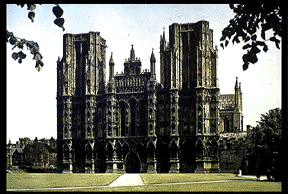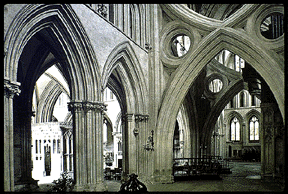Elizabeth Goudge Wells
Elizabeth Goudge Wells The birthplace of Elizabeth Goudge is England's smallest city. Visitors from the United States might think of it as a small town, rather than a city....but a city it is. When you visit Wells, you can come by auto or by bus. (England has an excellent bus service.)
The city used to be serviced by train and it was that train that brings Jocelyn to the city in the opening of City of Bells. But the train serviceno longer exists.
The city lies among the Mendip Hills in Somerset, England. The first time I visited there was a traffic jam just outside Oxford and so the bus was running late. It was clear I would miss my connection. To my surprise and delight the bus driver called ahead, found a connection from Bath and detoured to leave me at that city's bus depot. (This is one of the reasons why I praise National Express Bus service. I could not imagine a bus driver back home doing this sort of thing)
It was late afternoon when we left Bath for Wells and the bus made numerous local stops. But I got a wonderful view of the City...and its Cathedral ws we wound our way down the Mendip Hills. The Cathedral was of course, the first building visible over the tops of trees. A lovely way to arrive - it made sense of some of Goudge's remarks about those hills in her novels..
The city gets its name from its three wells. There is one in the market place and two on the grounds of the Bishop's Palace. But the City is dominated by this beautiful Cathdral. Here is a YOUTUBE video that shows the Cathedral as you see it across the green: Cathedral at Wells
Since the building of the A39/A37 bypass, the city has little auto or truck traffic and so it is pleasant to walk from Cathedral to shops to the Bishop's Palace. In this video, you approach the Cathedral from the city side. There is a view of the Penniless Porch that figures in City of Bells. Another approach to the Cathedral
Elizabeth Goudge Wells

Under the name of Torminster, Wells in Somerset, England the setting for several of Goudge's stories:
- City of Bells
- Henrietta's House - also published as The Blue Hills
- and Sister of the Angels
You will enjoy these stories more fully by having some sense of the Wells Cathedral and Close and that is why I offer you this page.
One of the most impressive sites are the Stairs to the Chapter House. These stairs are worn. They have deep indentations from the footsteps of monks and canons over the years. See: Wells Stairs to Chapter House
The Cathedral has two very special clocks:
Elizabeth Goudge Wells Cathedral She includes these clocks in her stories. One clock is on the outside of the building. It has knights that strike the bell to mark the passing of the hours. Tourists are often sitting in the benches or standing on the path in front of the clock waiting for the Knights to being their hourly chore. See: Exterior Clock of Wells Cathedral
(Here is another photo: of the exterior clock described in Elizabeth Goudge Wells stories
Inside of the Cathedral is another clock. It was designed by Peter Lightfoot, a monk of Glastonbury. This clock has been dated to the 14th century and it is one of the oldest clocks in the world. The actual clock now in the Cathedral is an updated version; the original still functioning works are in the London Science Museum. The Lightfoot clock is quite intricate. It has a number of figures: Jack Blandifers, who hit the bells, and jousting knights chase each other every 15 minutes.
Below this is a dial. The sun on the outer dial shows the hours, in roman numerals, from I to XII, then from I to XII again. This Double-XII system was common in Northern Europe at the time. The minutes are indicated by a star on the inside ring.
The clock also gives phases of the moon. The inner ring in the above image gives the moon's age - over 29 days. The black disk above the centre shows the moon's phase. The inscription around the moon phase is "sphericus archetypum globus hic monstrat microcosmum" [Trans. "This rounded ball displays a model of the universe in miniature"].
Elizabeth Goudge Wells con't. One can only imagine the joy of a sensitive child growing up in a world with such clocks. See: Lightfoots Clock
The Lady Chapel at Wells is extraordinary. It has plain glass and this plain glass allows the full light to enter. All along the walls are insets with stone carved figures. But what is arresting, almost shocking, is that the heads of all the statues along these walls are knocked off - victims of Cromwell's soldiers.
When I saw this, I understood for the first time Goudge's attitude toward these early reformers. Beauty destroyed. On the outside of the Cathedral all the statues as high as a man could reach with a lance when seated on a horse are also destroyed. Those above that height - including the Blessing Christ over the main door - are preserved. For someone so attuned to the beautiful I imagine the destruction was painful to see.

This nave with strainer arches gives some sense the grace and beauty that permeates Wells Cathedral.
It soars and even the chatting of tourists walking down the aisle can not prevent this architecture from raising one's spirits.
Another delight are the carvings found at the tops of pillars and hidden in other places throughout the cathedral. One is suddenly surprised dogs, cats and birds that are extraordinary rendered. These cathedral builders not only soared; they observed ordinary life very carefully and seem to have delighted in it.
When I visited Wells I noted that the Cathedral Music School was a point of great pride among city residents. If you want to learn more about this music school, and see some additional images, go to: Choristers of Wells Cathedral
If you visit Wells, I suggest that you begin with the Museum - a short visit there will make your visit to the Cathedral and the rest of the town much more meaningful.
Other pages:
- Elizabeth Goudge Home
- Ely
Home | Privacy | Financial Disclosure | Donate



